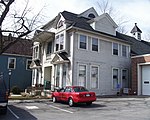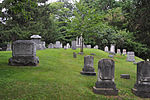Cox–Budlong House
Federal architecture in New York (state)Greek Revival architecture in New York (state)Houses completed in 1820Houses in Monroe County, New YorkHouses on the National Register of Historic Places in New York (state) ... and 3 more
Italianate architecture in New York (state)Monroe County, New York Registered Historic Place stubsNational Register of Historic Places in Monroe County, New York

The Cox–Budlong House is a historic house at 4396 River Road near Scottsville, Monroe County, New York.
Excerpt from the Wikipedia article Cox–Budlong House (License: CC BY-SA 3.0, Authors, Images).Cox–Budlong House
River Road, Town of Wheatland
Geographical coordinates (GPS) Address Nearby Places Show on map
Geographical coordinates (GPS)
| Latitude | Longitude |
|---|---|
| N 43.01383 ° | E -77.74671 ° |
Address
River Road 4396
14546 Town of Wheatland
New York, United States
Open on Google Maps











